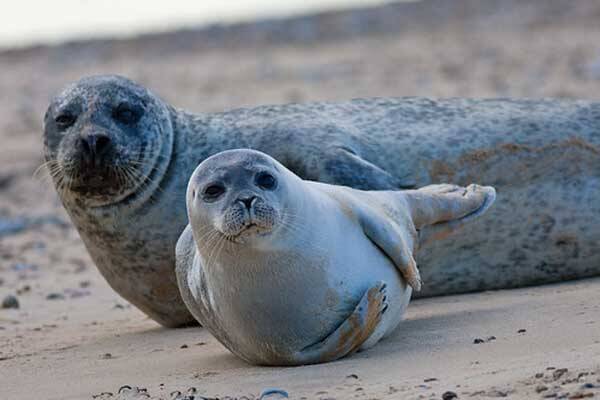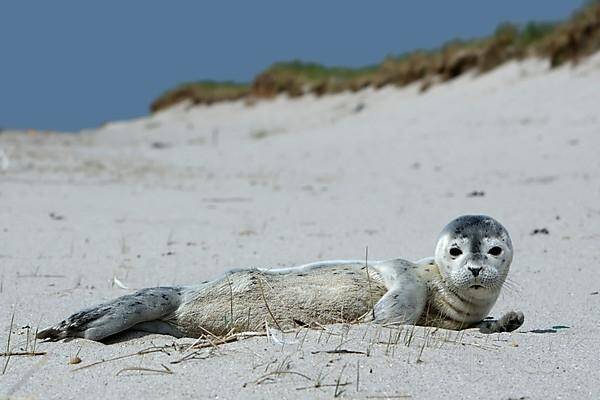Phoca vitulina
IUCN
LCBasic Information
Scientific classification
- name:Phoca vitulina
- Scientific Name:Phoca vitulina ,Common seal
- Outline:Carnivora
- Family:Phocaea
Vital signs
- length:1.2-1.6m
- Weight:50-128kg
- lifetime:20-35years
Feature
It often stays in the harbor, hence the name
Distribution and Habitat
Harbor seals are widely distributed in the temperate to Arctic waters of the North Atlantic and North Pacific, mainly along the eastern and western coasts of North America, the eastern and western coasts of Asia, and the northwestern coast of Europe. They tend to stay on the coast and will not stray more than 20 kilometers away.
Appearance
Adult harbor seals are 1.2 to 1.6 meters long from head to tail and weigh 50 to 128 kilograms. Female seals are generally smaller than male seals. The body of harbor seals is dark brown to yellowish brown or gray, with a lighter belly. Each one has unique spots or stripes. The body and flippers are very short, and the head is relatively large and round. The snout is V-shaped and there are no auricles. There is a large ear canal behind the eye.
Details
The scientific name of the harbor seal is Phoca vitulina (Linnaeus, 1758), and the foreign name is Common seal. It is a seal distributed in the temperate and polar waters of the Northern Hemisphere.

The harbor seal lives in groups, but the number of its groups is not as large as other seals. When not looking for food, they leave the water and go to their dens.
Harbor seals are very loyal to their habitat. They spend days at sea and swim up to 50 kilometers to find food, and they also swim to fresh water through rivers. Their dens are on rocky coasts or beaches such as the Hebrides or New England. They live in sandy intertidal zones, and some also go into estuaries to find food. Some even feed and play in New York Harbor and Boston Harbor. They often stay in the harbor, hence the name. They only stay in familiar environments, generally rocky areas that are inaccessible to land predators and have a sufficient supply of fish food.
Harbor seals mainly hunt fish such as herring, anchovies, perch, herring, cod, whiting and flatfish, and sometimes eat shrimp, crabs, mollusks and squid. They can dive for up to 10 minutes, reaching depths of 457 meters or more. They only rarely attack, kill and eat seabirds.

Harbor seals are polygamous, and female seals only give birth to one litter per year, with a gestation period of 9 months. Harbor seals come ashore to give birth every year, in February in low-latitude colonies and as late as July in the subarctic. Female seals are the only ones who feed their young, and they are weaned in about 4 to 6 weeks. Male seals only fight with other male seals. Studies have found that male seals gather in the water and call to attract female seals ready to mate. The young are well developed at birth and can swim and dive within a few hours. They weigh about 16 kilograms at birth and can weigh twice as much by the time they are weaned.
Harbor seals must stay on the shore when they molt shortly after breeding. This is particularly important in their life cycle, but they may be disturbed by humans. Female seals will mate again immediately after the young are weaned. Female seals live longer than male seals, living to 30 to 35 years, while males live 20 to 25 years.
Harbor seals number about 400,000 to 500,000, and are not endangered overall. Most subspecies are threatened in Greenland, Hokkaido, and the Baltic Sea, where populations have been decimated by disease outbreaks and human harassment. In the United Kingdom, Norway, and Canada, seal hunting is still legal if it is to protect fisheries, but commercial hunting is prohibited. Some seals are still hunted or become bycatch. In the United States, there are stricter restrictions and no hunting is allowed. On the East Coast of the United States, their numbers seem to be recovering, gradually returning to their previous habitat as far south as Georgia.
The IUCN Red List is listed as: Least Concern (LC)
Protect wild animals and stop eating game.
Maintaining ecological balance is everyone's responsibility!








